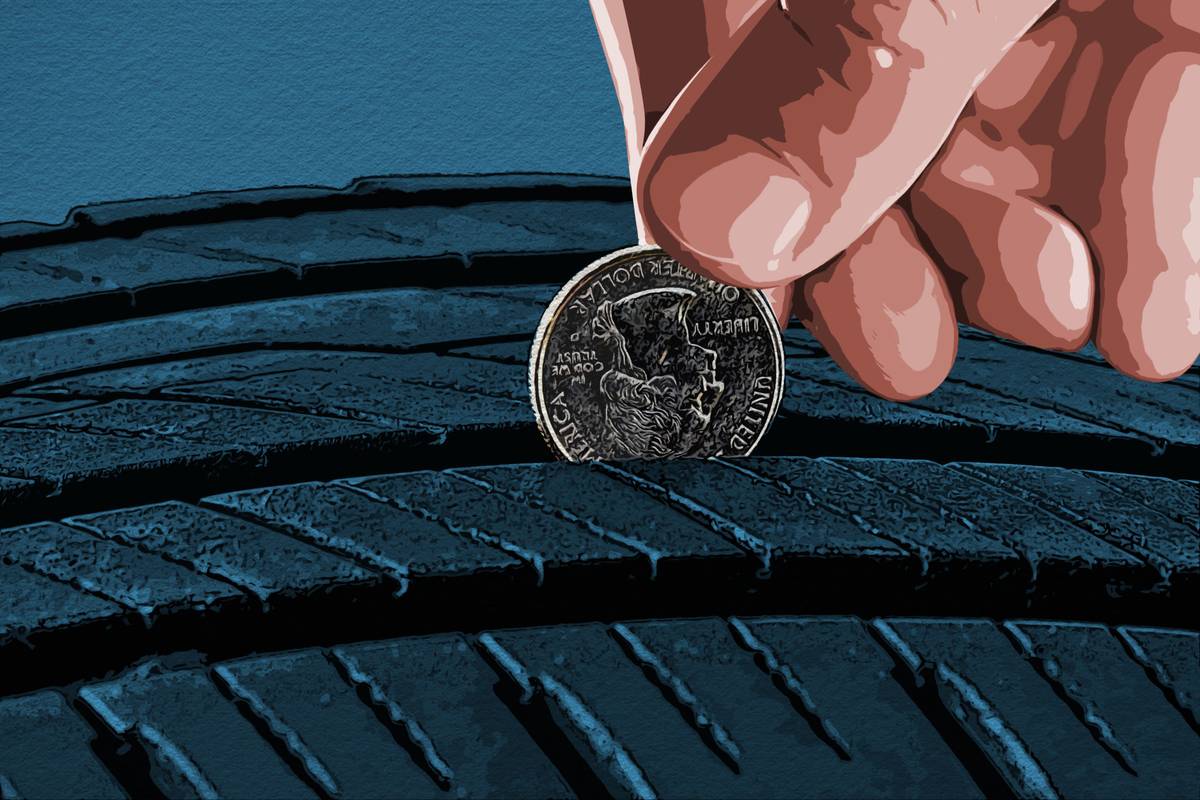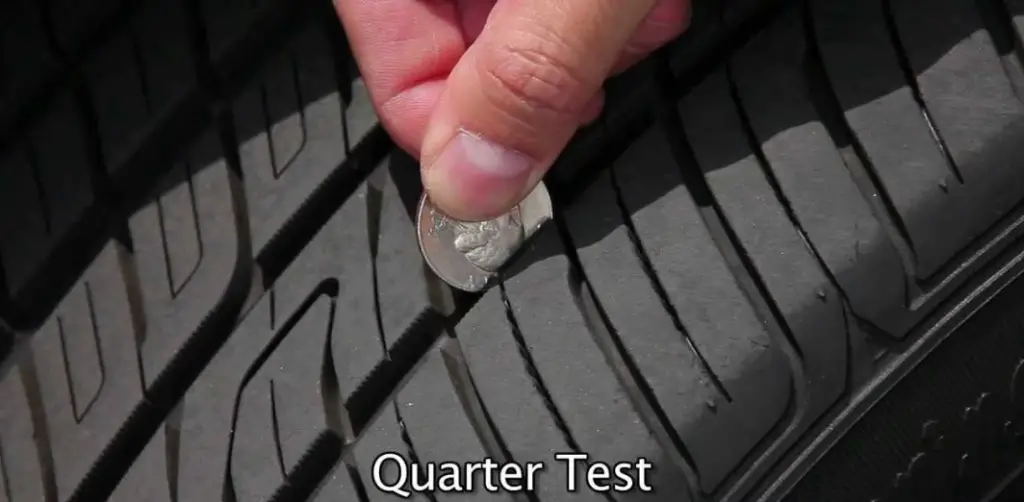To check tire tread depth, you can use simple methods like the penny test or quarter test, or opt for a more accurate tread depth gauge. For the penny test, place a penny into the tread grooves with Lincoln’s head facing down; if you can see the top of his head, the tread is below the legal limit of 2/32 of an inch. Modern tires may also have tread wear indicator bars that signal when your tires need replacing.
Tire tread depth is one of the most important factors that affect your vehicle’s safety, handling, and overall performance. Tires with adequate tread ensure optimal grip on the road, especially in wet or slippery conditions. As tires wear down over time, it becomes crucial to check tread depth regularly to ensure that your tires are still providing the necessary traction for safe driving.
In this blog post, we’ll discuss why tire tread depth is important, various methods to check it, the minimum legal and recommended tread depths, and tips to maintain your tires for longer tread life. Additionally, we’ll answer five frequently asked questions (FAQs) related to tire tread depth.

Credit: www.progressive.com
Contents
Why Tire Tread Depth Matters
Tire tread is the grooved part of the tire that makes contact with the road. It allows water, snow, and debris to pass through, ensuring the tire maintains a good grip on the road surface. Adequate tread depth ensures that:
- Traction is maintained: Tread gives your vehicle the ability to maintain traction on wet, dry, or icy roads.
- Water is properly channeled: The deeper the tread, the better your tires can expel water, which reduces the risk of hydroplaning.
- Braking performance is optimized: Tires with sufficient tread depth stop more quickly, which is crucial in emergency braking situations.
- Even tire wear is promoted: Ensuring that your tires are properly maintained, including checking tread depth, can extend the life of your tires and improve fuel efficiency.
Worn tires can increase stopping distances, reduce fuel efficiency, and cause dangerous situations on the road, particularly in wet or icy conditions. Keeping an eye on tread depth is critical for overall vehicle safety and performance.
Minimum Legal and Recommended Tread Depth
The legal minimum tread depth in many countries, including the United States, is 2/32 of an inch (about 1.6 mm). Once your tire tread reaches this depth, it’s time to replace your tires as they are considered bald and dangerous.
However, safety experts often recommend replacing your tires before they reach the legal minimum. A more conservative recommendation is to replace your tires once they reach 4/32 of an inch (3.2 mm), particularly if you drive in rainy conditions. For winter tires, many experts suggest replacing them when tread depth drops to 6/32 of an inch (4.8 mm), as deeper tread is needed for better traction on snow and ice.
How to Check Tire Tread Depth
There are several easy and effective ways to check your tire tread depth, ranging from simple DIY techniques to using specialized tools. Here are four common methods:
1. The Penny Test
The penny test is a simple and quick method to check your tire tread depth without any specialized tools.
- Take a U.S. penny and place it into the tread grooves of your tire with Abraham Lincoln’s head facing down.
- If you can see the top of Lincoln’s head, your tread is less than 2/32 of an inch, which means it’s time to replace the tires.
- If Lincoln’s head is partially covered by the tread, your tires are still safe to use but may need to be replaced soon.
This method works well to quickly determine if your tires are nearing the legal minimum tread depth.

Credit: www.cars.com
2. The Quarter Test
The quarter test is similar to the penny test but provides a more conservative estimate.
- Take a U.S. quarter and place it into the tread grooves with George Washington’s head facing down.
- If the top of Washington’s head is visible, your tread is less than 4/32 of an inch, meaning your tires may still be usable but should be replaced soon, especially if you frequently drive in rainy conditions.
The quarter test is a good way to check for early signs of wear, allowing you to replace your tires before they reach dangerous levels.

3. Tread Depth Gauge
A tread depth gauge is a specialized tool that provides an accurate measurement of your tire tread depth.
- Insert the probe of the gauge into the deepest part of the tread groove.
- Press the gauge down until it’s flush with the tread.
- Read the measurement on the gauge, which will indicate the exact tread depth.
Tread depth gauges are inexpensive and available at most auto parts stores, making them a reliable option for checking your tire tread with precision.
4. Tread Wear Indicator Bars
Many modern tires come with tread wear indicator bars, which are built into the tire tread.
- These small, raised bars run across the tire’s tread grooves.
- If the tread is worn down to the same level as the indicator bars, it’s a clear sign that your tires have reached the legal limit (2/32 of an inch) and need to be replaced.
Tread wear indicators provide an easy visual reference to gauge when your tires are no longer safe for use.
How Often Should You Check the Tire Tread Depth?
It’s recommended to check your tire tread depth at least once a month or before any long trips. You should also inspect your tires if you notice any changes in the way your vehicle handles, such as reduced grip, increased braking distance, or unusual vibrations. Regular tread checks can help you catch early signs of wear and avoid unsafe driving conditions.
Tips for Maintaining Tire Tread and Extending Tire Life
Maintaining your tires not only ensures they last longer but also improves your vehicle’s safety and fuel efficiency. Here are some tips to help extend the life of your tire tread:
1. Rotate Your Tires Regularly
Tires wear unevenly, especially on front-wheel-drive or rear-wheel-drive vehicles. To promote even wear, rotate the tires every 5,000 to 8,000 miles, or as recommended by your vehicle’s manufacturer.
2. Keep Tires Properly Inflated
Tires with improper inflation (either overinflated or underinflated) can wear unevenly and faster. Check your tire pressure monthly and ensure it matches the recommended PSI listed in your vehicle’s owner’s manual or door jamb.
3. Check Wheel Alignment
Misaligned wheels can cause uneven tire wear, shortening the lifespan of your tires. Have your alignment checked regularly, especially if you notice your vehicle pulling to one side or if you hit a pothole or curb.
4. Balance the Tires
Unbalanced tires can cause vibrations, uneven wear, and reduced tread life. Ensure your tires are properly balanced during installation and whenever you feel unusual vibrations while driving.
5. Avoid Aggressive Driving
Hard braking, fast cornering, and speeding can accelerate tire wear. Driving more smoothly and cautiously can help preserve your tread for a longer time.
Frequently Asked Questions
Here are some FAQs about checking the tire tread depth –
1. What is the minimum legal tire tread depth?
The legal minimum tire tread depth in most places is 2/32 of an inch (1.6 mm). Once your tread wears down to this level, the tire is considered unsafe and needs to be replaced.
2. How often should I check my tire tread depth?
You should check your tire tread depth at least once a month and before long trips. Regular checks help ensure your tires are safe and performing optimally.
3. What’s the safest tread depth for wet or icy conditions?
For wet conditions, it’s recommended to replace your tires when the tread reaches 4/32 of an inch. For snowy or icy conditions, tires should have a tread depth of at least 6/32 of an inch for better traction.
4. Can I rely on tread wear indicator bars?
Yes, tread wear indicator bars are a reliable and convenient way to check if your tires are nearing the legal minimum tread depth. When the tread wears down to the level of these bars, it’s time to replace your tires.
5. What causes uneven tire tread wear?
Uneven tire tread wear can be caused by several factors, including improper inflation, misalignment, unbalanced tires, or not rotating your tires regularly. Regular maintenance can help prevent uneven wear and extend tire life.
Conclusion
Maintaining proper tire tread depth is critical for ensuring your vehicle’s safety, performance, and efficiency. By regularly checking your tread depth using simple methods like the penny test, quarter test, or a tread depth gauge, you can ensure that your tires provide optimal traction and handling on the road.
Replace the tires once they reach the minimum tread depth to avoid safety risks like hydroplaning and reduced braking performance. Regular tire maintenance, such as rotations, alignments, and proper inflation, can help extend tread life and keep your tires in top condition for years to come.